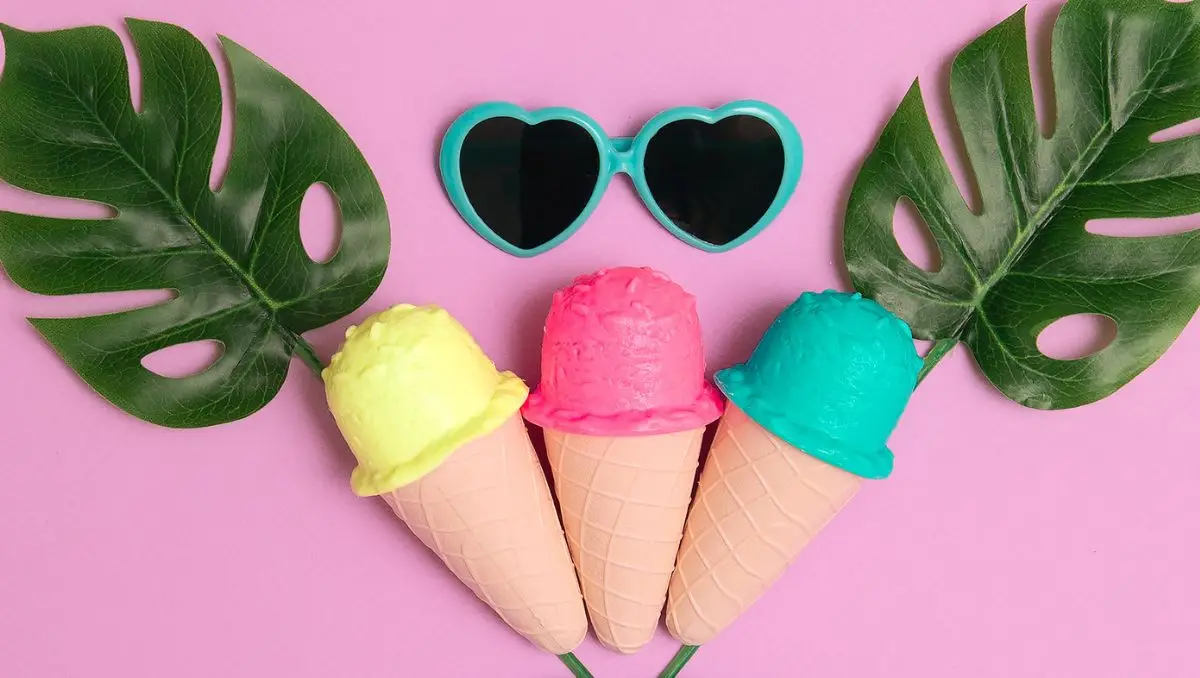Neon colors get their name from glowing neon gas signage that uses electrically charged noble gases to display vibrant, unique colors.
Until recently, these colors could not be truly achieved in pigments, making them a unique addition to 20th-century art.
This status is a great reason to discover new ways to use neon colors in your art, as the possibilities have only begun to be explored.
Many artists have now been using neon colors in painting, print, and sculpture, providing one of the unique elements of contemporary art.

What are Neon Colors?
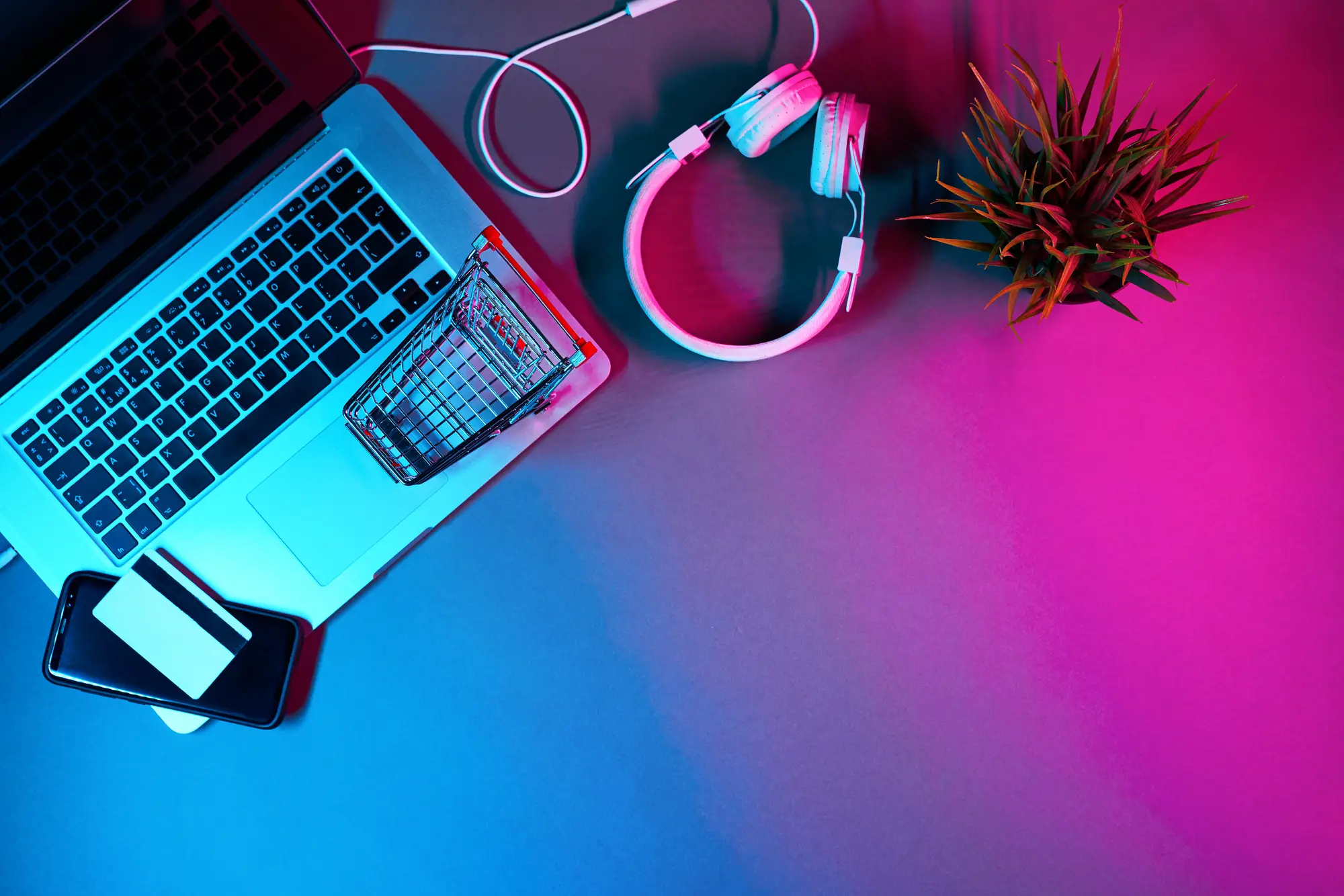
Neon colors come from the bright colors that shine out of noble gases when electricity is shot through them.
Each noble gas glows a unique color, giving a range of possible colors for neon signs to use.
In terms of fashion and general use of neon colors, the 1980s was the big breakthrough of neon in the mainstream.
Neon color design was used for lots of different fashion pieces, creating bright, attention-grabbing outfits.
Neon colors, at their heart, are simply extremely bright colors with high amounts of saturation.
They are best thought of as luminescent versions of primary and secondary colors.
Surprisingly, neon colors can only be chemically created, meaning they were not included in the traditional color spectrum.
We did not actually discover these colors as pigments until the early 20th century.
The most common use of neon colors is their use in neon signage.
Times Square in New York was one of the first major places to use a lot of neon, but Los Vegas became the true champion of its use.
Neon Color Names
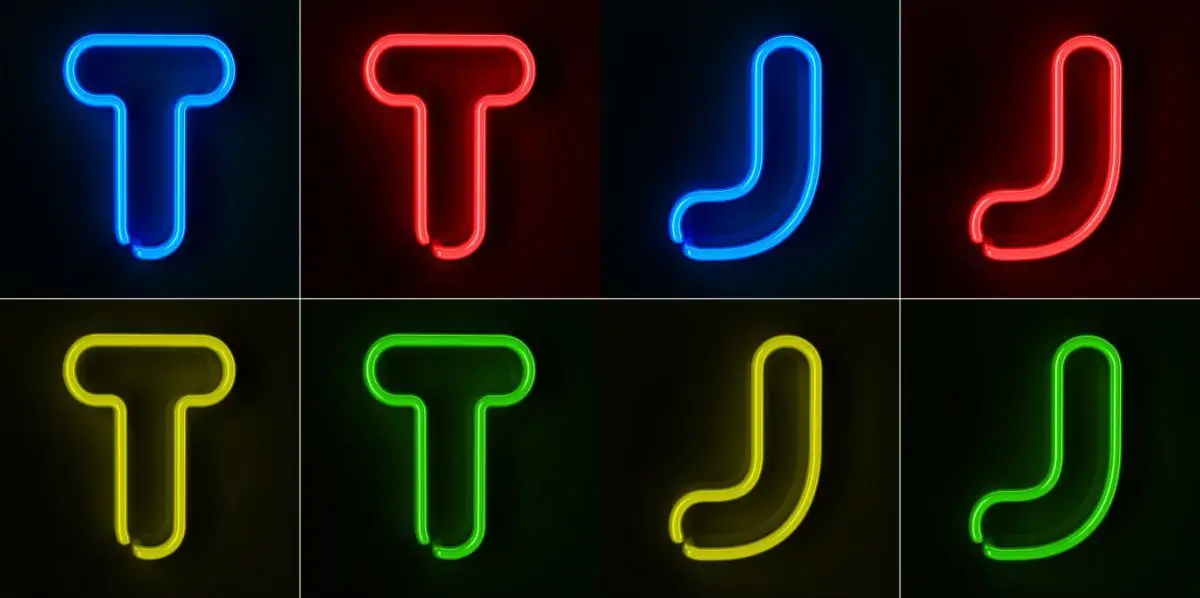
Each primary and secondary color has a neon color equivalent with its own special name, if not more than one.
Here’s a list of the more common names used for neon colors.
- Red – Neon Red
- Blue – Electric Blue, Cyan
- Yellow – Neon Yellow
- Pink – Neon Pink, Plastic Pink, Magenta
- Orange – Electric Orange
- Green – Neon Green, Lime Green, UFO Green
- Purple – Bright Purple, Proton Purple
You can find a lot more online and elsewhere, but this should give you a basic idea of the neon color names.
Neon Color History
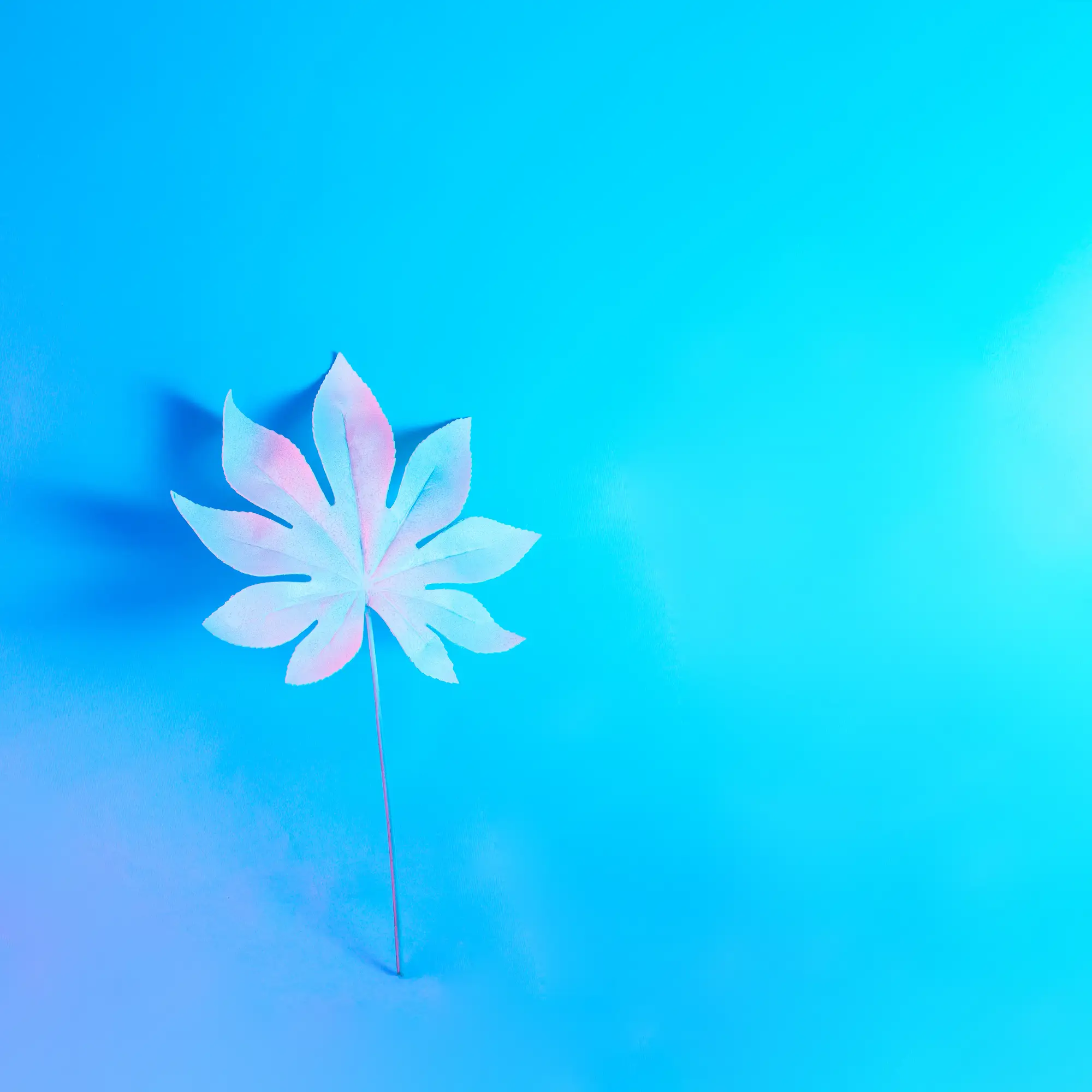
Neon lights were discovered earlier than one may have thought.
Their story begins back in 1675 when the astronomer Jean Picard found something glowing in a mercury barometer tube.
Before electricity was invented, scientists were aware of the ability to make certain chemical concoctions glow, particularly mercury vapor, but they didn’t know why this was the case or have any particular uses for it.
Essentially, the glow couldn’t yet be harnessed.
It wasn’t until later that the work of scientists such as Georges Claude would be able to make the first neon lamp.
Neon came from the term neos, meaning “the new gas.”
Neon is only one of the noble gases that glow, but any of them can be used when making ‘neon’ signs.
In 1923, he brought neon gas signs to the United States through his company and began the trend of using neon signs to attract attention to storefronts.
Luminescent paint, using neon colors in a pigment, was first invented by Bob Switzer in the 1930s.
Georges Claude was just a teenager living in Ohio when he was passing the time in a dark room playing around with fluorescent minerals.
He tried mixing wood varnish and luminescent minerals.
Claude was eventually able to make fluorescent paint.
He named the product Day-Glo, which was even used by the military in WWII for visibility.
Today, the highly visible colors are used on signage and safety clothing to either provide a warning or to help increase the visibility of workers on building sites.
Historical Use of Neon Colors
In the 1950s, a New York sign design company Artkraft Strauss, helped to popularize neon signs in Times Square.
But this trend began spreading further, fast.
When it comes to using neon-colored paint, the 1960s introduced Andy Warhol as its biggest advocate.
Many of his pop artworks used clashing neon colors to highlight celebrity culture.
He thought of neon as one of the greatest modern inventions.
Most famous is his collection of neon Marilyn Munroe prints in different contrasting colors, a masterclass in the use of neon for contemporary art.
Many artists have followed Warhol’s use of neon in many different directions, including sculping with neon colors or using neon to simulate new visual experiences.
Jeff Koons, for example, creates larger-than-life sculptures of seemingly one-use and cheap items to force us to re-evaluate their use in everyday life.
Many of his balloon animal sculptures, for example, use metallic and neon colors to get their point across.
It was then the 1980s that truly brought neon colors to their full potential, embracing the bright colors in many mainstream outlets.
In the 1990s, glow sticks became mainstream, using a chemical reaction to create neon colors.
This led to the substantial use of neon in the underground rave scene, which was extremely popular in the 90s and continues today in nightlife worldwide.
Neon Color Meaning

Almost every color has a neon equivalent, brighter and more saturated than its original.
They adopt some of the psychological associations of their base color but have many traits and associations all on their own.
For example, neon green breaks free of the ‘natural’ color of green, hinting at radioactivity or acid instead.
Neon blue, on the other hand, does still feel calm and collected, like regular blue.
Neon pink is a bright and playful pink.
The artificiality of neon gives it a brash and tasteless look which many people find repulsive. It strongly contrasts the supposedly chic and intellectual muted colors of the opera, academy, and government.
That said, it can represent rebellion, nightlife, and excessive fun.
Neon is most associated with the night, when neon signs get lit up, but also with our contemporary culture of fast-moving changes and attention-grabbing headlines.
This is probably due to the use of neon signs for big, flashy commercial spaces like casinos, hotels, and other high-consumption places.
Neon colors are also used on disposable party items, making them feel cheap and plastic as a color.
Neon Color Theory
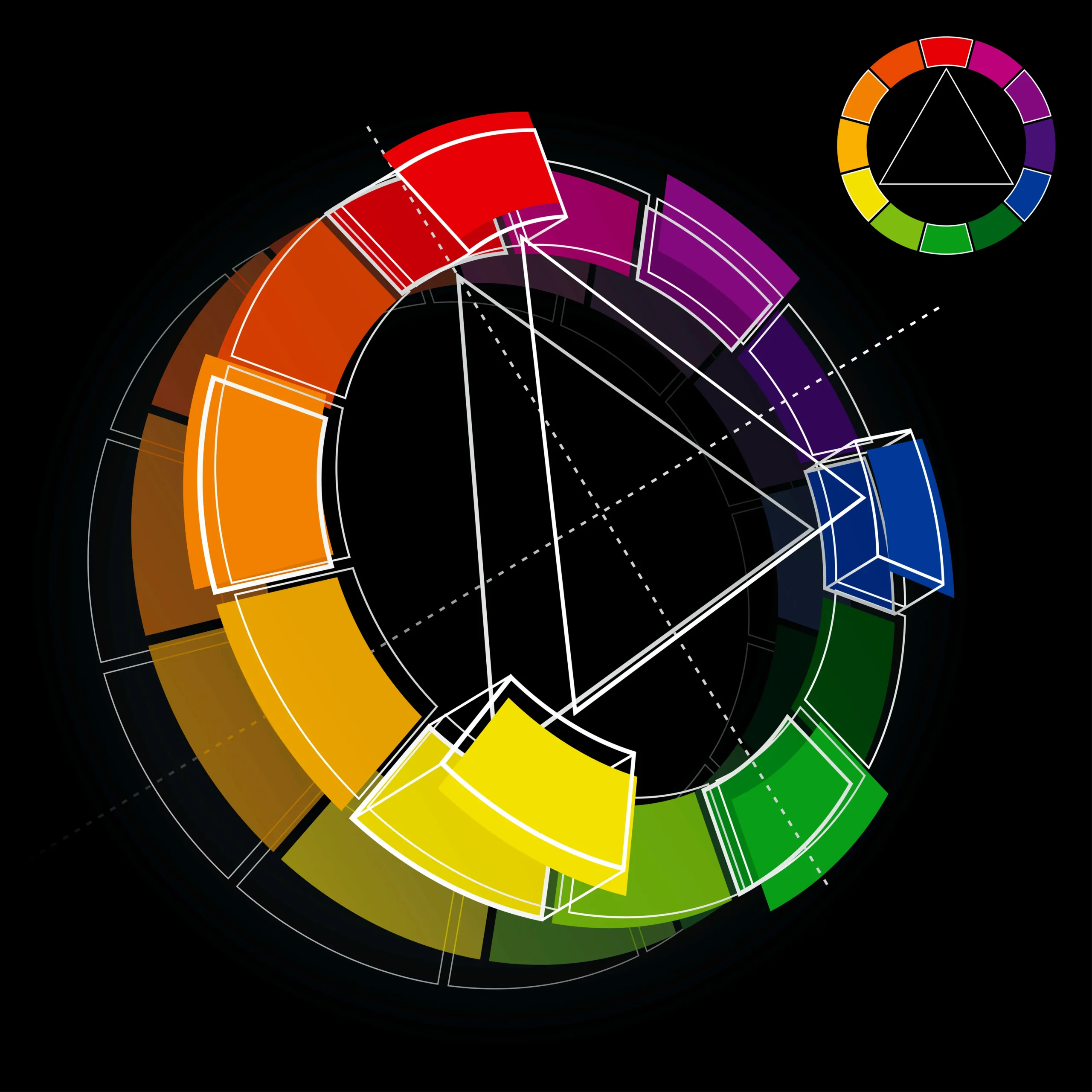
Figuring out where neon colors are on the color wheel is a difficult task.
They are not simply more saturated or bright versions of pure primary and secondary colors but have their own unique look.
The way they emit light in real life makes them almost ‘off the chart,’ when it comes to the original color wheel.
That’s why traditional color wheels before the 20th century don’t feature neon colors at all.
However, there are now relatively close approximations of the colors available to print and paint.
For the CMYK additive color model, layered colored inks are not really able to achieve fluorescent effects.
Printers have to turn to special pigments available from Pantone or similar to achieve true neon effects.
Digitally, neon is easier to replicate.
The way LCD screens emit RGB light allows neon colors to be replicated just as easily as other colors.
However, this has only been possible since color television and film, which is a relative latecomer.
Complimentary Colors
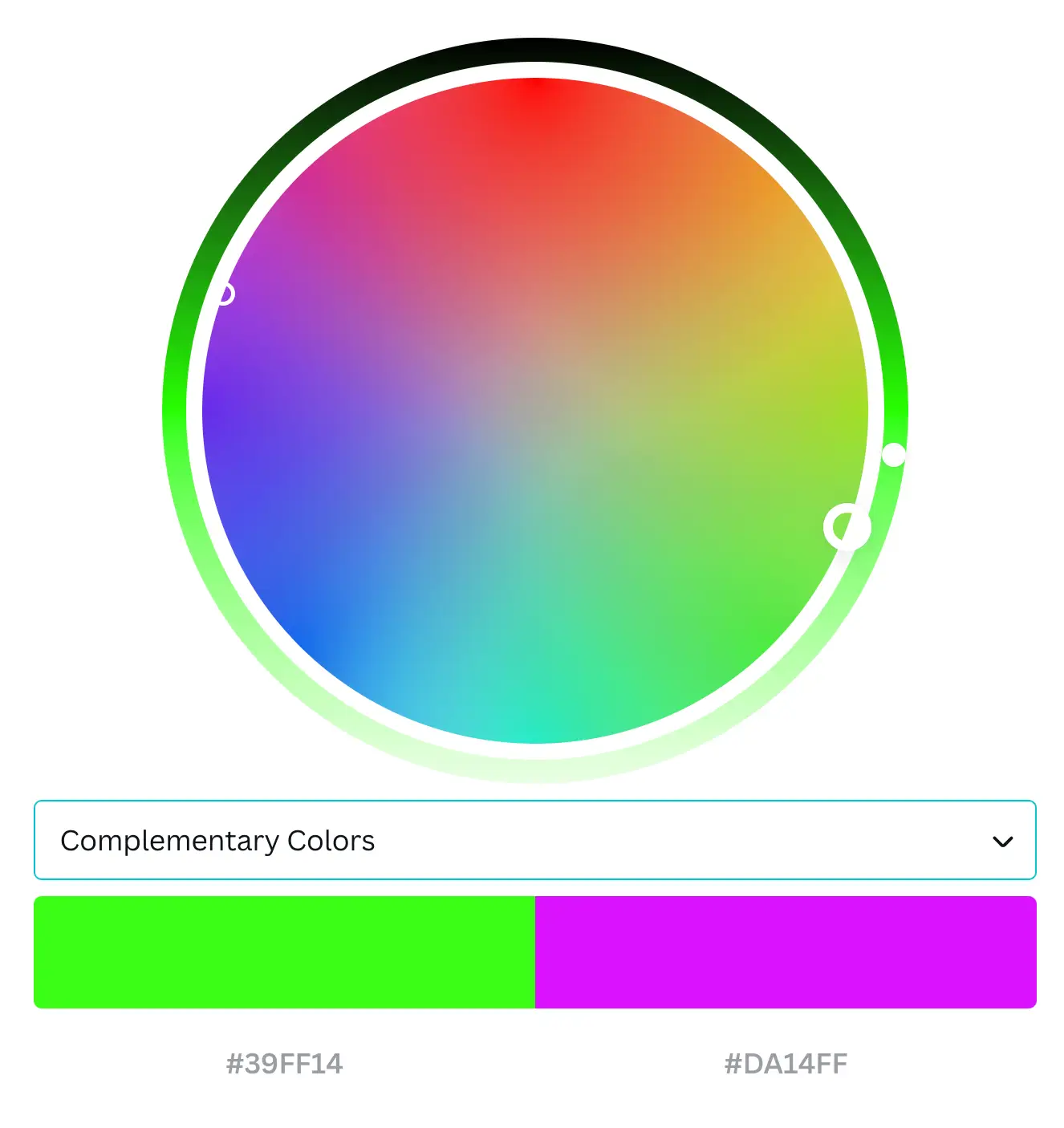
The neon versions of colors follow the same rules of complements as their regular colored counterparts.
So, if you’ve got a neon green, it pairs with a neon mauve color, similar to magenta.
A neon blue goes well with neon orange, while neon yellow goes well with neon purple.
All you have to do is look at a color wheel and select the non-neon version of the color you’re interested in finding the complement of, then pick the color on the opposite end of the color wheel.
Now, apply neon to both colors.
You can also look at their split complements. Split complements are the two colors adjacent to the complement of a color.
So, for example, with neon blue, its complement is neon orange.
Its split compliments are neon yellow and neon red, which is adjacent to orange on the color wheel.
Contrasting Colors

Now, there is another way to find contrasting colors, which is the triadic color scheme.
Take a color on the color wheel and use it as a point, make the other two points of an equilateral triangle on the wheel.
So, for example, magenta (neon pink), neon yellow-green, and a neon blue-violet are the other two points on the equilateral triangle.
These three make one of the triadic color schemes possible with neon colors.
Many artists and graphic designers have used such contrasting neon schemes to great effect in things like poster design, where the colors are extremely eye-catching.
They are also used in laser light shows, raves, clubs, and nightlife events.
Are Neon Colors Warm or Cool
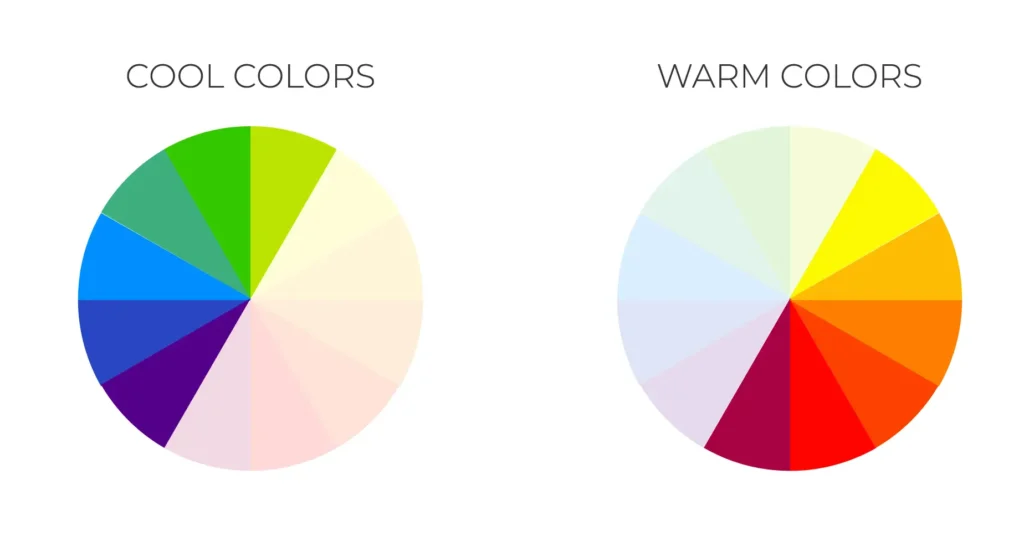
Each neon color will have its own kind of color temperature, but generally, it is harder to put them on the temperature scale because of just how glowing and saturated they are.
Normally, to determine if a color is warmer or cooler, you have to look at its undertones relative to other colors.
Neon colors have the surprising effect of overwhelming the temperature scale.
However, you can still look at the more regular version of each neon color and see how warm or cool it is though.
Neon Color Shades

Neon color shades have their own fun names depending on the color, for the major primary and secondary colors.
Funnily enough, many of these colors have been gaining massive popularity online for web design and print.
Neon Green
Neon Green
UFO Green
Electric Lime
| Color Name | Hex Code | RGB Code | CMYK Code |
| Neon Green | #39ff14 | 57, 255, 20 | 78, 0, 92, 0 |
| UFO Green | #7fff00 | 127, 255, 0 | 50, 0, 100, 0 |
| Electric Lime | #ccff00 | 204, 255, 0 | 20, 0, 100, 0 |
Neon green has the strongest ‘green’ saturation of the three, while electric lime lies more between a bright yellow and green.
UFO green is between the two.
All three colors have a strong brightness to them associated with neon colors.
Neon Yellow
Neon Yellow
Absinthe
Chartreuse
| Color Name | Hex Code | RGB Code | CMYK Code |
| Neon Yellow | #fff01f | 255, 240, 31 | 0, 6, 88, 0 |
| Absinthe | #e7ee4f | 231, 238, 79 | 3, 0, 67, 7 |
| Chartreuse Yellow | #dfff00 | 223, 255, 0 | 13, 0, 100, 0 |
Each of the neon yellows has its own amount of green and brightness associated with it.
Neon yellow itself is the purest yellow at a high brightness, while absinthe is more of an acid green-yellow and chartreuse is a very bright yellow-green.
Neon Red
| Color Name | Hex Code | RGB Code | CMYK Code |
| Neon Red | #ff3131 | 255, 49, 49 | 0, 81, 81, 0 |
Neon red is a bright red that takes a high saturation of red and brightens it into the neon red range.
Neon Pink
Neon Pink
Plastic Pink
Magenta
| Color Name | Hex Code | RGB Code | CMYK Code |
| Neon Pink | #ff10f0 | 255, 16, 240 | 0, 94, 6, 0 |
| Plastic Pink | #fb7bbb | 251,123,187 | 0, 51, 51, 2 |
| Magenta | #ff00ff | 255, 0, 255 | 0, 100, 0, 0 |
Neon pink is a more bright, pure pink, while plastic pink is in the barbie, cotton candy range. Magenta is a more purple-pink, but still with a extreme brightness.
Neon Blue
Neon Blue
Electric Cyan
| Color Name | Hex Code | RGB Code | CMYK Code |
| Neon Blue | #1f51ff | 31, 81, 255 | 88, 68, 0, 0 |
| Electric Cyan | #0ff0fc | 15, 240, 252 | 94, 5, 0, 1 |
Neon blue is more of a true blue with high saturation, while electric cyan is a bright cyan, more like the highlighter blue and really showing the cyan.
Neon Orange
| Color Name | Hex Code | RGB Code | CMYK Code |
| Electric Orange | #ff5e00 | 255, 94, 0 | 0, 63, 100, 0 |
Electric orange is a bright, highly saturated orange of the kind you might see with an orange highlighter.
Neon Purple
Neon Purple
Proton Purple
| Color Name | Hex Code | RGB Code | CMYK Code |
| Neon Purple | #bc13fe | 188, 19, 254 | 26, 93, 0, 0 |
| Proton Purple | #8a2be2 | 138, 43, 226 | 39, 81, 0, 11 |
Neon purple is more of a highly saturated, bright violet-mauve, while proton purple is closer to a true purple but brightened into the neon range.
Neon Color Combinations

With the increase in maximalist, eye-catching designs becoming popular since 2019, there has been a more experimental, fun use of color in both digital space and print.
One popular choice is the neon-on-neon design, where clashing neons bring an overwhelming vibrancy to a piece.
Often, this is paired with more neutral typography for a bold, modern aesthetic that gives a sense of youthful vibrancy.
Popular in fashion at the moment is the use of a mostly neutral-colored outfit with a shocking, clashing splash of neon somewhere in the outfit.
For example, a grey suite with a neon pink tie, or a beige dress with a neon green shoe.
This choice takes an otherwise quiet, elegant outfit and adds an attention-grabbing element that can’t be looked away from, allowing the mind to pause on the person.
For specific color combinations, try the following:
- Inspired by the colorful Holi festivals of India, you can combine magenta and electric orange for a bright, neon autumn color palette. Bright yellow and red can also work in this combination.
- Bright cyan and neon coral is another contrasting design that evokes blistering hot sunsets by the beach. It’s a summer aesthetic that draws attention.
- Finally, you can get inspired by the tropical rainforest colors of some psychedelic rainforest frogs and geckos. Neon green is the staple here, often paired with electric blue, orange, or bright yellow.
How to Make Neon Green Paint
You can get ready-made neon green paint at some art and paint stores, but mixing it with the right ingredients is possible.
You need a basic green or blue, but then a very bright yellow.
The yellow must be highly saturated in order for this to work.
Here’s a series of simple steps to follow to get it to work:
- First, place one part bright yellow pigment or paint into your mixing container.
- Then, add your oil if you are using a pigment.
- Then, add equal parts green pigment or paint and mix them together. You can add half as much blue pigment or paint if you have that instead.
- If the color is still not neon enough, you can go with more bright yellow to brighten it up.
How is Neon Different than Other Common Colors
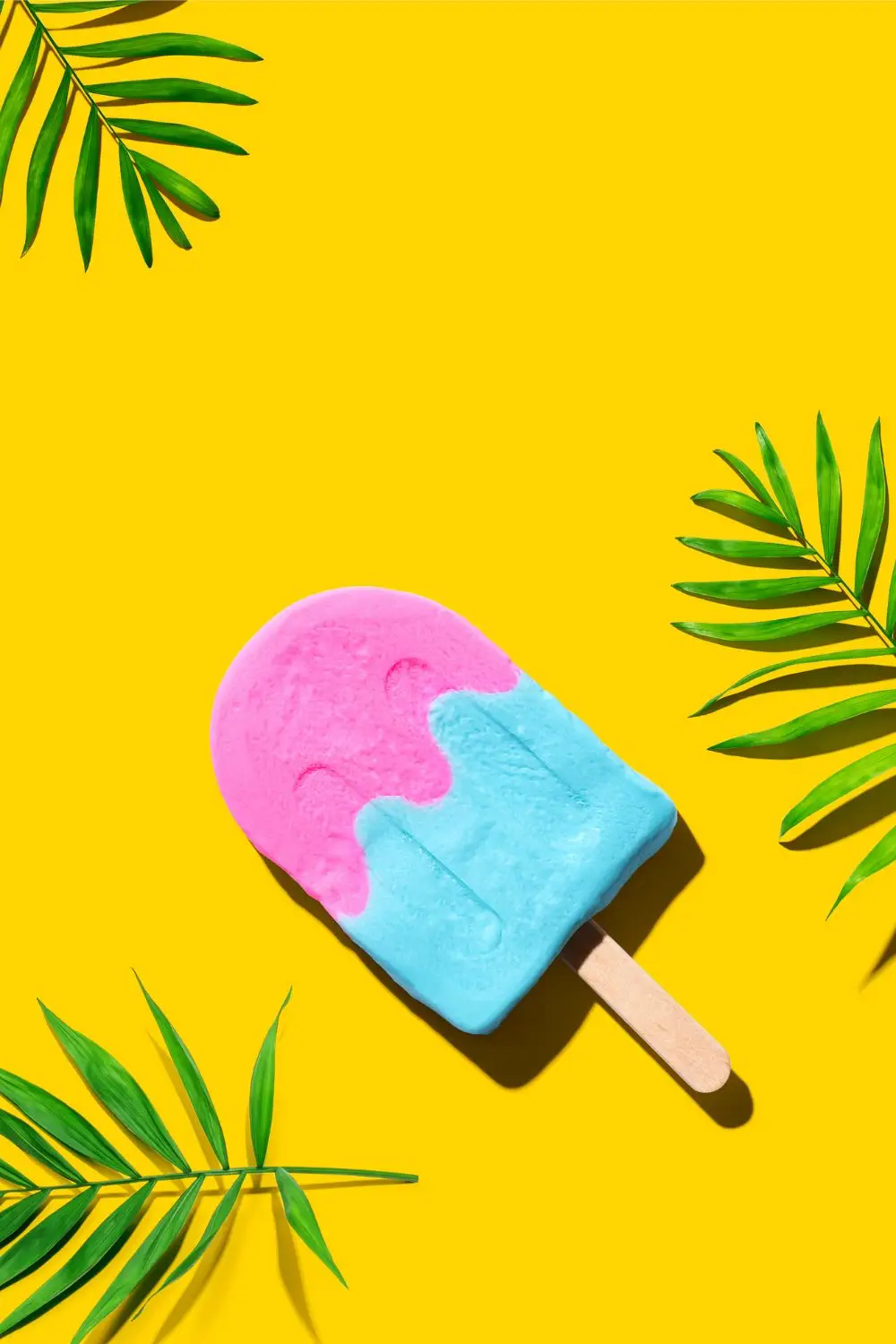
Neon is only really possible to make chemically or through digital means such as on a screen.
Before the advent of screens, neon was quite rare.
The colors get their name from the noble gases used to glow in different colors, neon gas glowing red. helium glows orange, argon lavender color, krypton green (where Superman’s kryptonite gets its name), xenon greyish blue, and mercury vapor glows light blue.
Before the invention of adding fluorescent minerals into pigments or using chemical mixtures, making these colors for print was essentially impossible.
For this reason, neon colors were not on traditional color wheels.
Neon Colors vs Fluorescent Colors
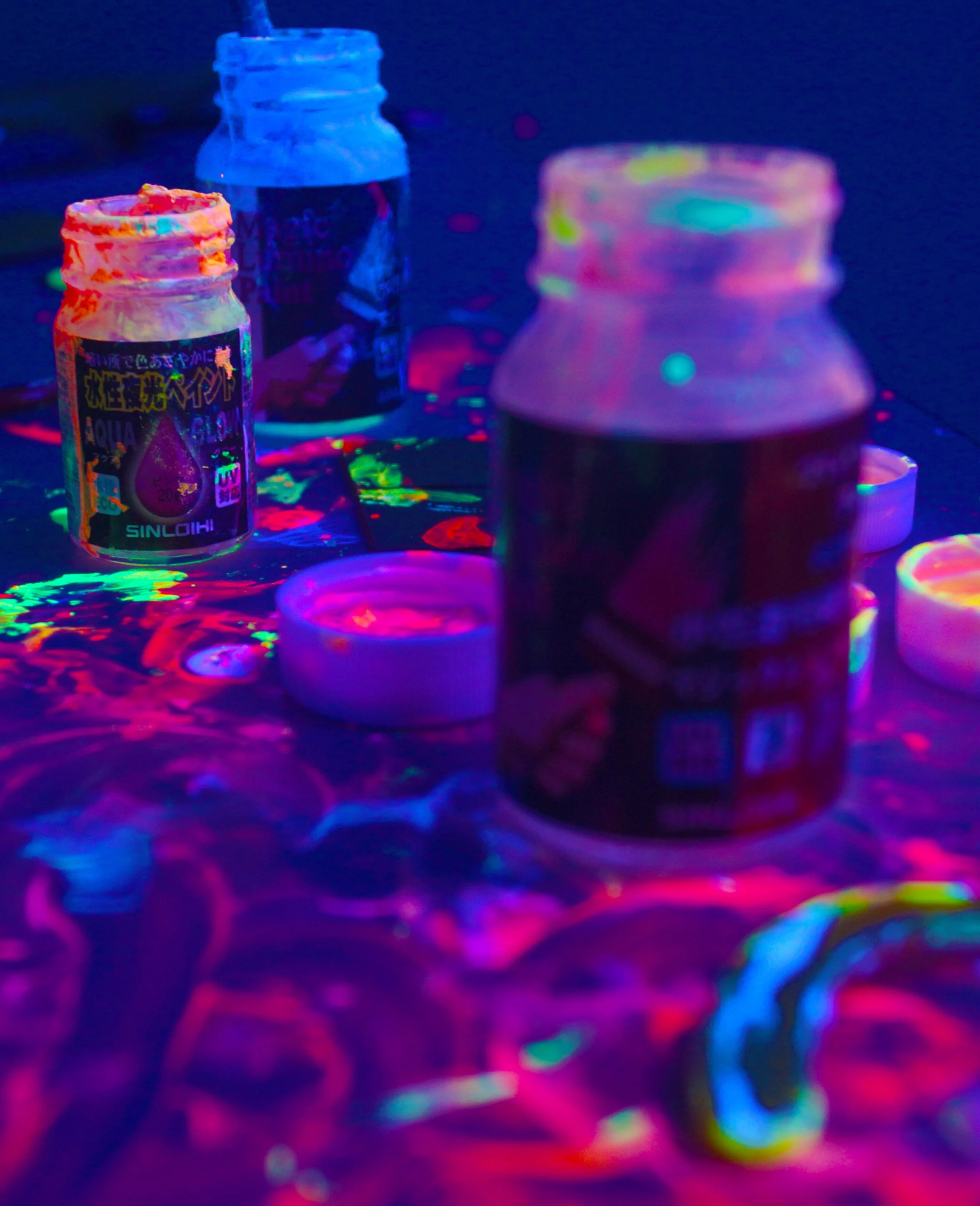
The terms neon and fluorescent are often used interchangeably, but they have individual meanings.
Neon lights use noble gases to get their colors and light, while fluorescents use mercury vapor.
Fluorescent lighting is very commonly used in industrial and commercial settings due to its cost-effectiveness in lighting large areas.
It also protects our eyes from UV radiation, which neon lights do not.
Now, in terms of colors, neon lights are much more associated with extremely bright, colorful neons, while fluorescents usually just come in bright white.
If a colored film is added, they can be other colors, but they don’t have the signature glare that true neon does.
Conclusion
Neon colors present a unique, almost uniquely 20th and 21st-century addition to the color wheel.
They are often seen as tacky, over-dramatic, and youthful, but in the art world, their presence has come to define whole movements of contemporary arts, including pop art and kitsch.
Very recently, neon colors in print and digital campaigns have become popular, making them a kind of color to look out for in trends.
Neon Colors FAQ
What colors go with neon green?
Neon green brings a bright, stark excitement to a space. It pairs best with pink as its complimentary and contrasting color, but anything in the red-violet range will work. This creates a powerful, eye-catching color scheme with a wild intensity.
What colors go with neon yellow?
Neon yellow’s best complementary colors are in the violet range, but you can also try neutrals such as gray or navy blue. It’s not easy to make neon yellow work, but with the right pairing, it can really pop.
What do neon colors symbolize?
Their biggest associations are with nightlife and joy. But specific ones do have their own symbols. Neon green is associated with radioactivity and acid, neon yellow with bio-hazard and safety.

